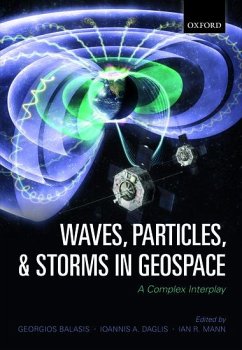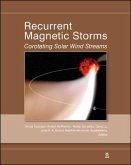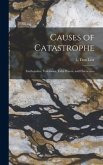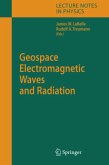Waves, Particles, and Storms in Geospace
Herausgeber: Balasis, Georgios
Waves, Particles, and Storms in Geospace
Herausgeber: Balasis, Georgios
- Gebundenes Buch
- Merkliste
- Auf die Merkliste
- Bewerten Bewerten
- Teilen
- Produkt teilen
- Produkterinnerung
- Produkterinnerung
The book presents an overview of the complex interplay of particles, fields, waves and currents in geospace, with an emphasis on wave-particle interactions and radiation belt dynamics.
Andere Kunden interessierten sich auch für
![Recurrent Magnetic Storms Recurrent Magnetic Storms]() Recurrent Magnetic Storms102,99 €
Recurrent Magnetic Storms102,99 €![Causes of Catastrophe; Earthquakes, Volcanoes, Tidal Waves, and Hurricanes Causes of Catastrophe; Earthquakes, Volcanoes, Tidal Waves, and Hurricanes]() Causes of Catastrophe; Earthquakes, Volcanoes, Tidal Waves, and Hurricanes35,99 €
Causes of Catastrophe; Earthquakes, Volcanoes, Tidal Waves, and Hurricanes35,99 €![Electric Currents in Geospace and Beyond Electric Currents in Geospace and Beyond]() Electric Currents in Geospace and Beyond271,99 €
Electric Currents in Geospace and Beyond271,99 €![Geospace Electromagnetic Waves and Radiation Geospace Electromagnetic Waves and Radiation]() Geospace Electromagnetic Waves and Radiation74,99 €
Geospace Electromagnetic Waves and Radiation74,99 €![Meteorology and Climatology of the Mediterranean and Black Seas Meteorology and Climatology of the Mediterranean and Black Seas]() Meteorology and Climatology of the Mediterranean and Black Seas74,99 €
Meteorology and Climatology of the Mediterranean and Black Seas74,99 €![After the Earth Quakes After the Earth Quakes]() Susan Elizabeth HoughAfter the Earth Quakes95,99 €
Susan Elizabeth HoughAfter the Earth Quakes95,99 €![The Earth's Magnetic Field The Earth's Magnetic Field]() William LowrieThe Earth's Magnetic Field100,99 €
William LowrieThe Earth's Magnetic Field100,99 €-
-
-
The book presents an overview of the complex interplay of particles, fields, waves and currents in geospace, with an emphasis on wave-particle interactions and radiation belt dynamics.
Produktdetails
- Produktdetails
- Verlag: Sydney University Press
- Seitenzahl: 468
- Erscheinungstermin: 24. Januar 2017
- Englisch
- Abmessung: 244mm x 175mm x 28mm
- Gewicht: 1066g
- ISBN-13: 9780198705246
- ISBN-10: 0198705247
- Artikelnr.: 47865779
- Verlag: Sydney University Press
- Seitenzahl: 468
- Erscheinungstermin: 24. Januar 2017
- Englisch
- Abmessung: 244mm x 175mm x 28mm
- Gewicht: 1066g
- ISBN-13: 9780198705246
- ISBN-10: 0198705247
- Artikelnr.: 47865779
Georgios Balasis is a senior researcher of the Institute for Astronomy, Astrophysics, Space Applications and Remote Sensing (IAASARS) at the National Observatory of Athens (NOA), Greece. He received a BSc in Physics from the of University of Athens (Greece), followed by an MSc in Geophysics from the University of Edinburgh (UK), an MSc in Condensed Matter Physics and a PhD in Applied Electromagnetism both from the University of Athens. From 2002 to 2006 he was the specialist for global electromagnetic induction in the CHAMP satellite team at GeoForschungsZentrum Potsdam (Germany). Dr. Balasis continues to be involved in magnetic satellite missions, in particular as member of the Validation Team of the Swarm satellite mission of the European Space Agency (ESA) and principal investigator of the Swarm Mission Science Exploration. His primary interest lies in Space Physics, with a focus on the dynamics of the magnetosphere and space weather forecasting. Ioannis A. Daglis is a professor in the Department of Physics at the National and Kapodistrian University of Athens, Greece. Before his appointment at the University of Athens, he was the Director of the Institute for Space Applications and Remote Sensing for six years (2006-2012) and the Director of the Institute for Astronomy, Astrophysics, Space Applications and Remote Sensing for one year (2012-2013). His scientific expertise pertains to solar system astrophysics and space applications. Prof. Daglis graduated from the Physics Department of the Aristotle University of Thessaloniki. He worked on his PhD in Space Plasma Electrodynamics at the Max Planck Institute for Solar System Research (Germany) and the Johns Hopkins University Applied Physics Laboratory (USA) under the supervision of the late Prof. Sir W. Ian Axford. Ian R. Mann is a professor in the Department of Physics at the University of Alberta, Canada, and was a Canada Research Chair in Space Physics from 2003-13. His research specialises in the study of the impacts of the sun on near-Earth space, including being an expert in the study of ultra-low frequency plasma waves and their impacts on energetic particle dynamics, including on the radiation belts, ring current, as well as and energy transport in the coupled geospace system and in relation to the generation of the aurora. He obtained his PhD in Applied Mathematics from the University of St. Andrews U.K., following receipt of a degree in Physics with Astrophysics from the University of Birmingham, U.K. He worked as a post-doctoral researcher at the University of London, U.K., and the University of Alberta, Canada, and was awarded a UK NSERC Post-Doctoral Fellowship. He worked as a Lecturer at the University of York, U.K. from before joining the faculty at the University of Alberta, Canada.
* Preface
* Waves, Particles, and Storms in Geospace: An Introduction
* 1: D. N. Baker: Wave and Particle Measurements in Earth's
Neighborhood: A Historical Mission Overview
* 2: Kazue Takahashi and Yoshizumi Miyoshi: Introduction to
Wave-Particle Interactions and their Impact on Energetic Particles in
Geospace
* 3: Geoffrey D. Reeves and Ioannis A. Daglis: Geospace Magnetic Storms
and the Van Allen Radiation Belts
* 4: Scot R. Elkington and Theodore E. Sarris: The Role of Pc-5 ULF
Waves in the Radiation Belts: Current Understanding and Open
Questions
* 5: S. Bourdarie, V. K. Jordanova, M. Liemohn, and T. P. O'Brien:
Modeling the Energetic Particles of the Inner Magnetosphere
* 6: Georgios Balasis, Constantinos Papadimitriou, Eftyhia Zesta, and
Viacheslav Pilipenko: Monitoring ULF Waves from Low Earth Orbit
Satellites
* 7: Colin Waters and Fred Menk: Monitoring Magnetospheric Waves from
the Ground
* 8: Jacob Bortnik, Richard M. Thorne, Wen Li, and Xin Tao: Chorus
Waves in Geospace and their Influence on Radiation Belt Dynamics
* 9: Richard B. Horne, Nigel P. Meredith, Sarah A. Glauert, and Tobias
Kersten: Wave-Driven Diffusion in Radiation Belt Dynamics
* 10: Maria E. Usanova and Ian R. Mann: Understanding the Role of EMIC
Waves in Radiation Belt and Ring Current Dynamics: Recent Advances
* 11: O. Santolík: Multi-dimensional Analysis of Whistler-mode Waves in
the Radiation Belt Region
* 12: D. L. Turner and V. Angelopoulos: Extreme Variability of
Relativistic Electrons in Earth's Outer Radiation Belt: An Overview
and Recent Revelations
* 13: Y. Miyoshi, R. Kataoka, and Y. Ebihara: Flux Enhancement of
Relativistic Electrons Associated with Substorms
* 14: M. A. Clilverd, C. J. Rodger, M. E. Andersson, A. Seppälä, and P.
T. Verronen: Linkages Between the Radiation Belts, Polar Atmosphere
and Climate: Electron Precipitation Through Wave Particle
Interactions
* 15: N. Krupp, E. Roussos, C. Paranicas, A. Sicard, G. Hospodarsky,
and Y. Shprits: Energetic Particles and Waves in the Outer Planet
Radiation Belts
* 16: C. A. Kletzing: Fields and Waves Influencing Radiation Belt
Dynamics -- Results from the Van Allen Probes Mission
* 17: Harlan E. Spence, Geoff D. Reeves, and Ramona Kessel: An Overview
of Early Results from the Radiation Belt Storm Probes Energetic
Particle, Composition, and Thermal Plasma Suite on NASA's Van Allen
Probes Mission
* Waves, Particles, and Storms in Geospace: An Introduction
* 1: D. N. Baker: Wave and Particle Measurements in Earth's
Neighborhood: A Historical Mission Overview
* 2: Kazue Takahashi and Yoshizumi Miyoshi: Introduction to
Wave-Particle Interactions and their Impact on Energetic Particles in
Geospace
* 3: Geoffrey D. Reeves and Ioannis A. Daglis: Geospace Magnetic Storms
and the Van Allen Radiation Belts
* 4: Scot R. Elkington and Theodore E. Sarris: The Role of Pc-5 ULF
Waves in the Radiation Belts: Current Understanding and Open
Questions
* 5: S. Bourdarie, V. K. Jordanova, M. Liemohn, and T. P. O'Brien:
Modeling the Energetic Particles of the Inner Magnetosphere
* 6: Georgios Balasis, Constantinos Papadimitriou, Eftyhia Zesta, and
Viacheslav Pilipenko: Monitoring ULF Waves from Low Earth Orbit
Satellites
* 7: Colin Waters and Fred Menk: Monitoring Magnetospheric Waves from
the Ground
* 8: Jacob Bortnik, Richard M. Thorne, Wen Li, and Xin Tao: Chorus
Waves in Geospace and their Influence on Radiation Belt Dynamics
* 9: Richard B. Horne, Nigel P. Meredith, Sarah A. Glauert, and Tobias
Kersten: Wave-Driven Diffusion in Radiation Belt Dynamics
* 10: Maria E. Usanova and Ian R. Mann: Understanding the Role of EMIC
Waves in Radiation Belt and Ring Current Dynamics: Recent Advances
* 11: O. Santolík: Multi-dimensional Analysis of Whistler-mode Waves in
the Radiation Belt Region
* 12: D. L. Turner and V. Angelopoulos: Extreme Variability of
Relativistic Electrons in Earth's Outer Radiation Belt: An Overview
and Recent Revelations
* 13: Y. Miyoshi, R. Kataoka, and Y. Ebihara: Flux Enhancement of
Relativistic Electrons Associated with Substorms
* 14: M. A. Clilverd, C. J. Rodger, M. E. Andersson, A. Seppälä, and P.
T. Verronen: Linkages Between the Radiation Belts, Polar Atmosphere
and Climate: Electron Precipitation Through Wave Particle
Interactions
* 15: N. Krupp, E. Roussos, C. Paranicas, A. Sicard, G. Hospodarsky,
and Y. Shprits: Energetic Particles and Waves in the Outer Planet
Radiation Belts
* 16: C. A. Kletzing: Fields and Waves Influencing Radiation Belt
Dynamics -- Results from the Van Allen Probes Mission
* 17: Harlan E. Spence, Geoff D. Reeves, and Ramona Kessel: An Overview
of Early Results from the Radiation Belt Storm Probes Energetic
Particle, Composition, and Thermal Plasma Suite on NASA's Van Allen
Probes Mission
* Preface
* Waves, Particles, and Storms in Geospace: An Introduction
* 1: D. N. Baker: Wave and Particle Measurements in Earth's
Neighborhood: A Historical Mission Overview
* 2: Kazue Takahashi and Yoshizumi Miyoshi: Introduction to
Wave-Particle Interactions and their Impact on Energetic Particles in
Geospace
* 3: Geoffrey D. Reeves and Ioannis A. Daglis: Geospace Magnetic Storms
and the Van Allen Radiation Belts
* 4: Scot R. Elkington and Theodore E. Sarris: The Role of Pc-5 ULF
Waves in the Radiation Belts: Current Understanding and Open
Questions
* 5: S. Bourdarie, V. K. Jordanova, M. Liemohn, and T. P. O'Brien:
Modeling the Energetic Particles of the Inner Magnetosphere
* 6: Georgios Balasis, Constantinos Papadimitriou, Eftyhia Zesta, and
Viacheslav Pilipenko: Monitoring ULF Waves from Low Earth Orbit
Satellites
* 7: Colin Waters and Fred Menk: Monitoring Magnetospheric Waves from
the Ground
* 8: Jacob Bortnik, Richard M. Thorne, Wen Li, and Xin Tao: Chorus
Waves in Geospace and their Influence on Radiation Belt Dynamics
* 9: Richard B. Horne, Nigel P. Meredith, Sarah A. Glauert, and Tobias
Kersten: Wave-Driven Diffusion in Radiation Belt Dynamics
* 10: Maria E. Usanova and Ian R. Mann: Understanding the Role of EMIC
Waves in Radiation Belt and Ring Current Dynamics: Recent Advances
* 11: O. Santolík: Multi-dimensional Analysis of Whistler-mode Waves in
the Radiation Belt Region
* 12: D. L. Turner and V. Angelopoulos: Extreme Variability of
Relativistic Electrons in Earth's Outer Radiation Belt: An Overview
and Recent Revelations
* 13: Y. Miyoshi, R. Kataoka, and Y. Ebihara: Flux Enhancement of
Relativistic Electrons Associated with Substorms
* 14: M. A. Clilverd, C. J. Rodger, M. E. Andersson, A. Seppälä, and P.
T. Verronen: Linkages Between the Radiation Belts, Polar Atmosphere
and Climate: Electron Precipitation Through Wave Particle
Interactions
* 15: N. Krupp, E. Roussos, C. Paranicas, A. Sicard, G. Hospodarsky,
and Y. Shprits: Energetic Particles and Waves in the Outer Planet
Radiation Belts
* 16: C. A. Kletzing: Fields and Waves Influencing Radiation Belt
Dynamics -- Results from the Van Allen Probes Mission
* 17: Harlan E. Spence, Geoff D. Reeves, and Ramona Kessel: An Overview
of Early Results from the Radiation Belt Storm Probes Energetic
Particle, Composition, and Thermal Plasma Suite on NASA's Van Allen
Probes Mission
* Waves, Particles, and Storms in Geospace: An Introduction
* 1: D. N. Baker: Wave and Particle Measurements in Earth's
Neighborhood: A Historical Mission Overview
* 2: Kazue Takahashi and Yoshizumi Miyoshi: Introduction to
Wave-Particle Interactions and their Impact on Energetic Particles in
Geospace
* 3: Geoffrey D. Reeves and Ioannis A. Daglis: Geospace Magnetic Storms
and the Van Allen Radiation Belts
* 4: Scot R. Elkington and Theodore E. Sarris: The Role of Pc-5 ULF
Waves in the Radiation Belts: Current Understanding and Open
Questions
* 5: S. Bourdarie, V. K. Jordanova, M. Liemohn, and T. P. O'Brien:
Modeling the Energetic Particles of the Inner Magnetosphere
* 6: Georgios Balasis, Constantinos Papadimitriou, Eftyhia Zesta, and
Viacheslav Pilipenko: Monitoring ULF Waves from Low Earth Orbit
Satellites
* 7: Colin Waters and Fred Menk: Monitoring Magnetospheric Waves from
the Ground
* 8: Jacob Bortnik, Richard M. Thorne, Wen Li, and Xin Tao: Chorus
Waves in Geospace and their Influence on Radiation Belt Dynamics
* 9: Richard B. Horne, Nigel P. Meredith, Sarah A. Glauert, and Tobias
Kersten: Wave-Driven Diffusion in Radiation Belt Dynamics
* 10: Maria E. Usanova and Ian R. Mann: Understanding the Role of EMIC
Waves in Radiation Belt and Ring Current Dynamics: Recent Advances
* 11: O. Santolík: Multi-dimensional Analysis of Whistler-mode Waves in
the Radiation Belt Region
* 12: D. L. Turner and V. Angelopoulos: Extreme Variability of
Relativistic Electrons in Earth's Outer Radiation Belt: An Overview
and Recent Revelations
* 13: Y. Miyoshi, R. Kataoka, and Y. Ebihara: Flux Enhancement of
Relativistic Electrons Associated with Substorms
* 14: M. A. Clilverd, C. J. Rodger, M. E. Andersson, A. Seppälä, and P.
T. Verronen: Linkages Between the Radiation Belts, Polar Atmosphere
and Climate: Electron Precipitation Through Wave Particle
Interactions
* 15: N. Krupp, E. Roussos, C. Paranicas, A. Sicard, G. Hospodarsky,
and Y. Shprits: Energetic Particles and Waves in the Outer Planet
Radiation Belts
* 16: C. A. Kletzing: Fields and Waves Influencing Radiation Belt
Dynamics -- Results from the Van Allen Probes Mission
* 17: Harlan E. Spence, Geoff D. Reeves, and Ramona Kessel: An Overview
of Early Results from the Radiation Belt Storm Probes Energetic
Particle, Composition, and Thermal Plasma Suite on NASA's Van Allen
Probes Mission








